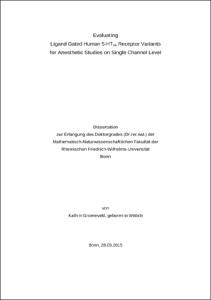Groeneveld, Kathrin: Evaluating Ligand Gated Human 5-HT3A Receptor Variants for Anesthetic Studies on Single Channel Level. - Bonn, 2016. - Dissertation, Rheinische Friedrich-Wilhelms-Universität Bonn.
Online-Ausgabe in bonndoc: https://nbn-resolving.org/urn:nbn:de:hbz:5n-43057
Online-Ausgabe in bonndoc: https://nbn-resolving.org/urn:nbn:de:hbz:5n-43057
@phdthesis{handle:20.500.11811/6730,
urn: https://nbn-resolving.org/urn:nbn:de:hbz:5n-43057,
author = {{Kathrin Groeneveld}},
title = {Evaluating Ligand Gated Human 5-HT3A Receptor Variants for Anesthetic Studies on Single Channel Level},
school = {Rheinische Friedrich-Wilhelms-Universität Bonn},
year = 2016,
month = apr,
note = {5-HT3A receptor channels have served in extensive macroscopic electrophysiological studies as a model to study effects of anesthetics and their related compounds on ligand-gated ion channels. Here, studies on the single channel level are pursued in order to provide a more detailed understanding of anesthetic induced effects on ion channels. Two high conductance forms of 5 HT3 receptors are characterized and evaluated for their usefulness for single channel kinetic analysis of anesthetic interactions with ion channels.
Expression of human heteromeric 5-HT3AB receptor channels was possible but problematic. There was evidence for functional co-existing 5-HT3A homomers in cells transfected with both A and B subunits so that their individual properties could not be isolated. In addition, the proportion of functional heteromers decreased with the number of cell passages until none could be detected.
5-HT3AQDA is the least modified high conductance mutant of homomeric 5 HT3A receptor channels. Single channel data for human 5-HT3AQDA receptor channels as a function of serotonin concentration confirm, in principle, the need for a complex kinetic model such as that proposed by Corradi et al. for mouse 5 HT3AQDA receptor channels. The data also indicate the need for adjusting this model for the human 5 HT3AQDA receptor.
The macroscopic characterization showed that 5-HT3AQDA receptors are similar to wild-type 5-HT3A receptors in their sensitivity to 5-HT and in their onset and offset kinetics, although the latter are accelerated and the rectification properties are changed. Thus, it is important to characterize the macroscopic effects of each substance on 5-HT3AQDA receptors before proceeding to single channel measurements. Macroscopic studies with propofol and hexanol show mostly a high level of similarity between 5 HT3A and 5 HT3AQDA receptor channel behavior.
Propofol and phenol affected not just one but many aspects of 5 HT3AQDA single channel kinetics. For propofol, the results confirmed not only the well-described inhibitory effects, but also provided direct evidence for an additional potentiating effect that had previously been indirectly inferred from macroscopic experiments.
Human 5-HT3AQDA receptor channels are a suitable model for future substance studies at single channel level and provide additional insights into the diverse and complex effects of anesthetics on ligand-gated ion channels.},
url = {https://hdl.handle.net/20.500.11811/6730}
}
urn: https://nbn-resolving.org/urn:nbn:de:hbz:5n-43057,
author = {{Kathrin Groeneveld}},
title = {Evaluating Ligand Gated Human 5-HT3A Receptor Variants for Anesthetic Studies on Single Channel Level},
school = {Rheinische Friedrich-Wilhelms-Universität Bonn},
year = 2016,
month = apr,
note = {5-HT3A receptor channels have served in extensive macroscopic electrophysiological studies as a model to study effects of anesthetics and their related compounds on ligand-gated ion channels. Here, studies on the single channel level are pursued in order to provide a more detailed understanding of anesthetic induced effects on ion channels. Two high conductance forms of 5 HT3 receptors are characterized and evaluated for their usefulness for single channel kinetic analysis of anesthetic interactions with ion channels.
Expression of human heteromeric 5-HT3AB receptor channels was possible but problematic. There was evidence for functional co-existing 5-HT3A homomers in cells transfected with both A and B subunits so that their individual properties could not be isolated. In addition, the proportion of functional heteromers decreased with the number of cell passages until none could be detected.
5-HT3AQDA is the least modified high conductance mutant of homomeric 5 HT3A receptor channels. Single channel data for human 5-HT3AQDA receptor channels as a function of serotonin concentration confirm, in principle, the need for a complex kinetic model such as that proposed by Corradi et al. for mouse 5 HT3AQDA receptor channels. The data also indicate the need for adjusting this model for the human 5 HT3AQDA receptor.
The macroscopic characterization showed that 5-HT3AQDA receptors are similar to wild-type 5-HT3A receptors in their sensitivity to 5-HT and in their onset and offset kinetics, although the latter are accelerated and the rectification properties are changed. Thus, it is important to characterize the macroscopic effects of each substance on 5-HT3AQDA receptors before proceeding to single channel measurements. Macroscopic studies with propofol and hexanol show mostly a high level of similarity between 5 HT3A and 5 HT3AQDA receptor channel behavior.
Propofol and phenol affected not just one but many aspects of 5 HT3AQDA single channel kinetics. For propofol, the results confirmed not only the well-described inhibitory effects, but also provided direct evidence for an additional potentiating effect that had previously been indirectly inferred from macroscopic experiments.
Human 5-HT3AQDA receptor channels are a suitable model for future substance studies at single channel level and provide additional insights into the diverse and complex effects of anesthetics on ligand-gated ion channels.},
url = {https://hdl.handle.net/20.500.11811/6730}
}






